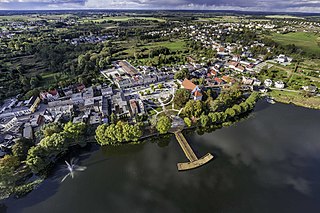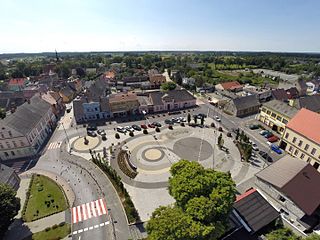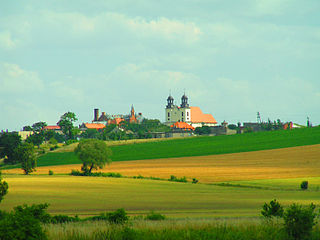
Inowrocław is a city in central Poland with a total population of 68,101. It is situated in the Kuyavian-Pomeranian Voivodeship. It is one of the largest and most historically significant cities within the historic region of Kuyavia.

The Noteć is a river in central Poland with a length of 391 km (243 mi) and a basin area of 17,302 km2 (6,680 sq mi). It is the largest tributary of the Warta river and lies completely within Poland.

Czarnków is a town in Poland in Czarnków-Trzcianka County in Greater Poland Voivodeship. As of December 2021, the town has 10,279 inhabitants.

Wyrzysk is a town in Poland with 5,263 (2004) inhabitants, situated in Piła County, Greater Poland Voivodeship.

Krajna is a forested historical region in the north of Greater Poland in Poland, situated in the border area between the Greater Poland, Kuyavian-Pomeranian and Pomeranian Voivodeships. The region consists of parts of Złotów, Piła, Sępólno, Nakło, Bydgoszcz and Człuchów counties, namely the urban gmina of Złotów, the rural gmina of Złotów and the urban-rural gminas of Krajenka, Wysoka, Wyrzysk, Łobżenica, Kamień Krajeński, Sępólno Krajeńskie, Więcbork, Nakło nad Notecią, Koronowo and Debzno. The name of Krajna is derived from the Slavic word for borderland, cf. Krajina.

Szubin is a town in Nakło County, Kuyavian-Pomeranian Voivodeship, Poland, located southwest of Bydgoszcz. It has a population of around 9,333. It is located on the Gąsawka River in the ethnocultural region of Pałuki.

Kcynia is a town in Nakło County, Kuyavian-Pomeranian Voivodeship, in north-central Poland, with 4,702 inhabitants (2010). It is located in the Pałuki ethnographic region in the northern part of historic Greater Poland.

Mrocza is a town in Nakło County, Kuyavian-Pomeranian Voivodeship, northern Poland, with 4,368 inhabitants (2010). It is located in the ethnocultural region of Krajna.

Paterek is a village in the administrative district of Gmina Nakło nad Notecią, within Nakło County, Kuyavian-Pomeranian Voivodeship, in north-central Poland. It lies approximately 4 kilometres (2 mi) south-east of Nakło nad Notecią and 26 km (16 mi) west of Bydgoszcz. It is located in the region of Pałuki.

Polichno is a village in the administrative district of Gmina Nakło nad Notecią, within Nakło County, Kuyavian-Pomeranian Voivodeship, in north-central Poland. It lies approximately 4 kilometres (2 mi) south-west of Nakło nad Notecią and 31 km (19 mi) west of Bydgoszcz. It is located in the ethnographic region of Pałuki.
Rozwarzyn is a village in the administrative district of Gmina Nakło nad Notecią, within Nakło County, Kuyavian-Pomeranian Voivodeship, in north-central Poland. It lies approximately 4 kilometres (2 mi) south-west of Nakło nad Notecią and 29 km (18 mi) west of Bydgoszcz. It is located in the ethnographic region of Pałuki.
Samoklęski Małe is a village in the administrative district of Gmina Szubin, within Nakło County, Kuyavian-Pomeranian Voivodeship, in north-central Poland. It lies approximately 6 kilometres (4 mi) north of Szubin, 12 km (7 mi) south-east of Nakło nad Notecią, and 20 km (12 mi) west of Bydgoszcz.

Tur is a village in the administrative district of Gmina Szubin, within Nakło County, Kuyavian-Pomeranian Voivodeship, in north-central Poland. It lies approximately 8 kilometres (5 mi) north of Szubin, 12 km (7 mi) south-east of Nakło nad Notecią, and 19 km (12 mi) west of Bydgoszcz. It is situated on the Noteć river.
Anieliny is a village in the administrative district of Gmina Sadki, within Nakło County, Kuyavian-Pomeranian Voivodeship, in north-central Poland. It lies approximately 5 kilometres (3 mi) south-east of Sadki, 7 km (4 mi) west of Nakło nad Notecią, and 34 km (21 mi) west of Bydgoszcz.
Bnin is a village in the administrative district of Gmina Sadki, within Nakło County, Kuyavian-Pomeranian Voivodeship, in north-central Poland. It lies approximately 5 kilometres (3 mi) south-west of Sadki, 13 km (8 mi) west of Nakło nad Notecią, and 41 km (25 mi) west of Bydgoszcz.
Dębionek is a village in the administrative district of Gmina Sadki, within Nakło County, Kuyavian-Pomeranian Voivodeship, in north-central Poland. It lies approximately 7 kilometres (4 mi) north of Sadki, 13 km (8 mi) north-west of Nakło nad Notecią, and 39 km (24 mi) west of Bydgoszcz.
Kraczki is a village in the administrative district of Gmina Sadki, within Nakło County, Kuyavian-Pomeranian Voivodeship, in north-central Poland. It lies approximately 6 kilometres (4 mi) north-west of Sadki, 16 km (10 mi) west of Nakło nad Notecią, and 43 km (27 mi) west of Bydgoszcz.
Radzicz is a village in rural Gmina Sadki, within Nakło County, Kuyavian-Pomeranian Voivodeship, in north-central Poland. It lies approximately 5.5 kilometres (3 mi) north-west of Sadki, 15 km (9 mi) north-west of Nakło nad Notecią, and 42 km (26 mi) west of Bydgoszcz.

Sadki is a village in Nakło County, Kuyavian-Pomeranian Voivodeship, in north-central Poland. It is the seat of the gmina called Gmina Sadki. It lies approximately 11 kilometres (7 mi) west of Nakło nad Notecią and 38 km (24 mi) west of Bydgoszcz.

Greater Poland, often known by its Polish name Wielkopolska, is a Polish historical region of west-central Poland. Its chief and largest city is Poznań followed by Kalisz, the oldest city in Poland.


























